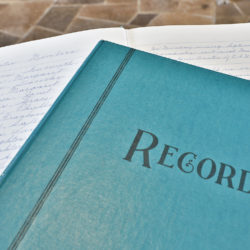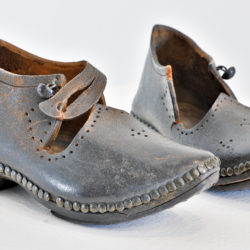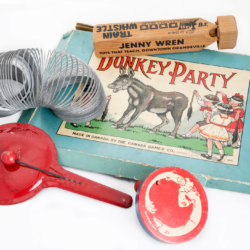THE ARCHIVES COLLECTION
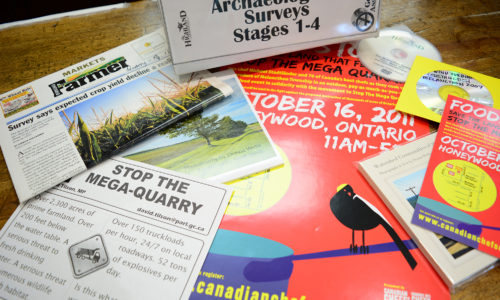
We are Dufferin County’s memory – a living collection of personal, business and municipal government records illuminating Dufferin’s history and identity. The archives collects documentary records and papers, photographs, oral history and newspapers that highlight the history of the County and its people.
The archives reading room has the latest technology to support all research needs, and the friendly and knowledgeable staff are available to assist researchers. Whether you’re looking to climb your family tree or detail the history of your property, we can help!
What We Have
-
- By-Laws & Municipal Council Minutes
- Assessment & Collectors Rolls
- Land Records
- Genealogy / Family History Records
- Local Newspapers dating from 1861
- School Records
- Maps, Atlases
- Cemetery Transcriptions and Indexes to Church Records
- Photographs and Post Cards
How to View
Researchers can visit the MoD Archives to see original documents or records. The Reading Room is open for drop-ins on Thursdays & Fridays, 11:00 am to 4:00 pm, with a closure for lunch from 12:30 – 1:30 pm. Appointments to visit the Archives are required on Tuesdays, Wednesdays, and Saturdays. Please call 519-941-1114 x 4014 or email the Archivist to make an appointment.
Retrieval services are available. Microfilm readers and printer services are available. Visitors are encouraged to bring their own computers or tablets.
We also invite you to visit the Archives’ Digital Archives database and our Online Collections database.
FEATURE STORY
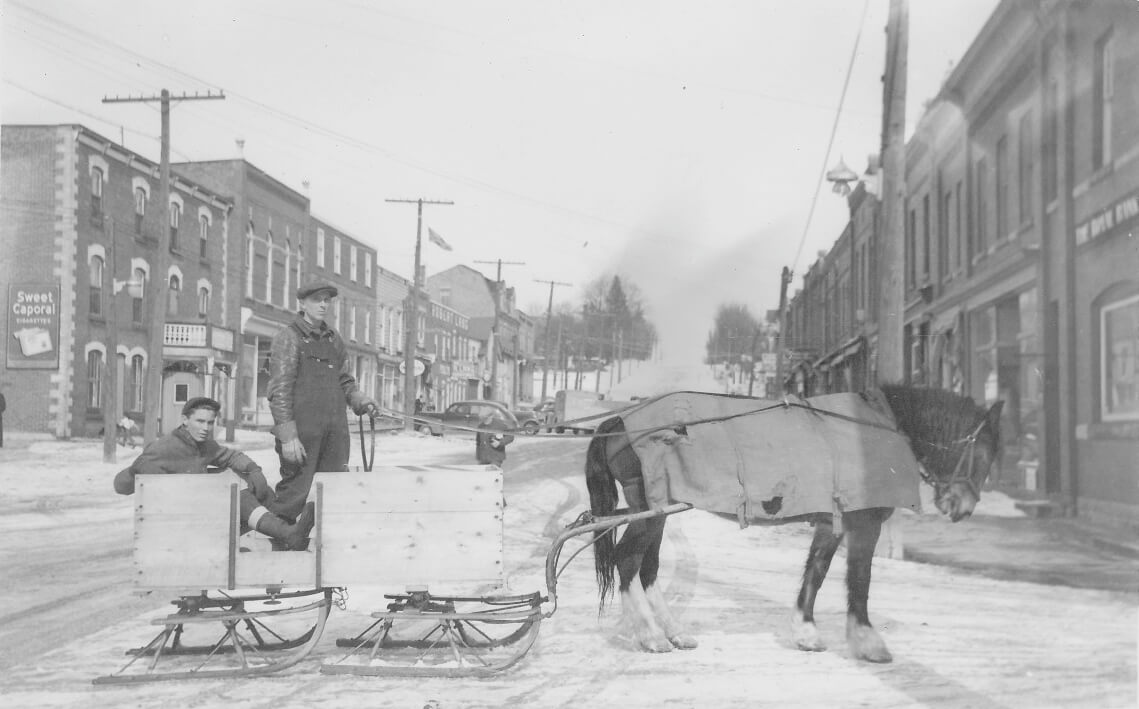
The Museum of Dufferin Archives collects the images, documents and stories of Dufferin and the people who call it home. Every item in the archives tells a special story, although it may not always be obvious at first. Photographs are among the most donated items to the Museum of Dufferin Archives. They can show you so many things – what life was like, what the towns looked like, what your grandmother’s farm looked like, or in this case, tell the story of a well-known horse named Maude.
In 1936 Wilbert Stuckey (standing in the sleigh) bought the Richardson house on the SE corner of Main and Mill Streets (currently “Marie’s Valley Inn Restaurant” and is the oldest building in Grand Valley, built in 1870). He used part of the house for his dairy business and the property behind the house to the east had a large barn and stable where he kept about 8 cows. In an era of daily door-to-door milk delivery, Wilbert and his horse-drawn sleigh or wagon became a fixture of Grand Valley.
In the early 1940s Wilbert purchased a 3-year old mare from Gordon Smeltzer of the Rockwood area. The horse was transported from Rockwood to Grand Valley, tied to the back of a Greenwood Construction gravel truck. The mare, known to one and all as “Maude”, became the milk wagon horse for four different owners of the Grand Valley Dairy. She knew the route by heart and stopped and started by voice commands. As Maude’s delivery talents were so well known, she often became a requirement of the sale! In 1958, after almost 20 years of making deliveries, Maude was retired to Harvey Montgomery’s East Luther farm.
Just looking at this picture, the story of the horse may not have been the first one you thought of, but it was the main reason for ensuring this image was added to the collection at the Museum of Dufferin.
History of the Grand Valley Dairy:
Wilbert Stuckey took over the dairy business from his mother, Mrs. Stephen S. (Agnes) Stuckey, in 1931. In the 1940s, after selling off his own livestock, Wilbert installed a pasteurizing plant. Wilbert’s main milk suppliers were William Graham, Morris Crane and George Young. He ran and operated the “Grand Valley Dairy” for17 years. He sold the dairy to Chester Ryan in January 1948, after deciding to go into the restaurant business. Chester sold the dairy in December that same year to John White of Camilla. In 1956 Irvine and Vada McCrone purchased the business. Each time, Maude the horse was included in the sale of the dairy. Two years later when the McCrones sold the milk business to Arthur Dairy and the milk processing was relocated to Arthur, Maude was retired to pasture. The McCrones kept the restaurant and dairy bar portion of the business.
THE ARTIFACT COLLECTION
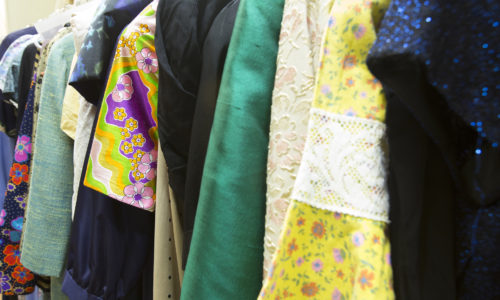
The MoD artifact collection contains 3D objects and art that have been generously donated by the community and beyond. These artifacts hold memories and are important tools for teaching future generations about the history of our region. The MoD’s diverse collection is carefully stored and preserved inside the museum. Artifacts are selected to match exhibition topics and themes and they come and go from display often.
What We Have
The MoD is home to a diverse collection of over 18,000 object (artifact) records. Examples from the MoD collection include:
- Glassware, most notably W.J. Hughes Corn Flower
- Fine art, including Dufferin-born artists Roy Austin and Bernice Fenwick
- Large transportation artifacts, such as wagons and sleighs
- Housewares and everyday items, such as dairy bottles, tins and crocks
- Local businesses souvenirs and signs
- Textiles, including quilts and military uniforms
- Vintage toys and games
How to View
It is the museum’s responsibility to preserve Dufferin County’s artifacts for future generations to enjoy. Factors such as dust, light, pests and handling by humans damage these fragile artifacts. Therefore, when an artifact is not on display it is kept safely in our temperature and humidity controlled storage rooms. Should you wish to have an artifact pulled to view in person, we ask that you make an appointment with the Curator. Generally, 3 days’ notice is required. Please email Curator, Sarah Robinson.
FEATURED ARTIFACTS
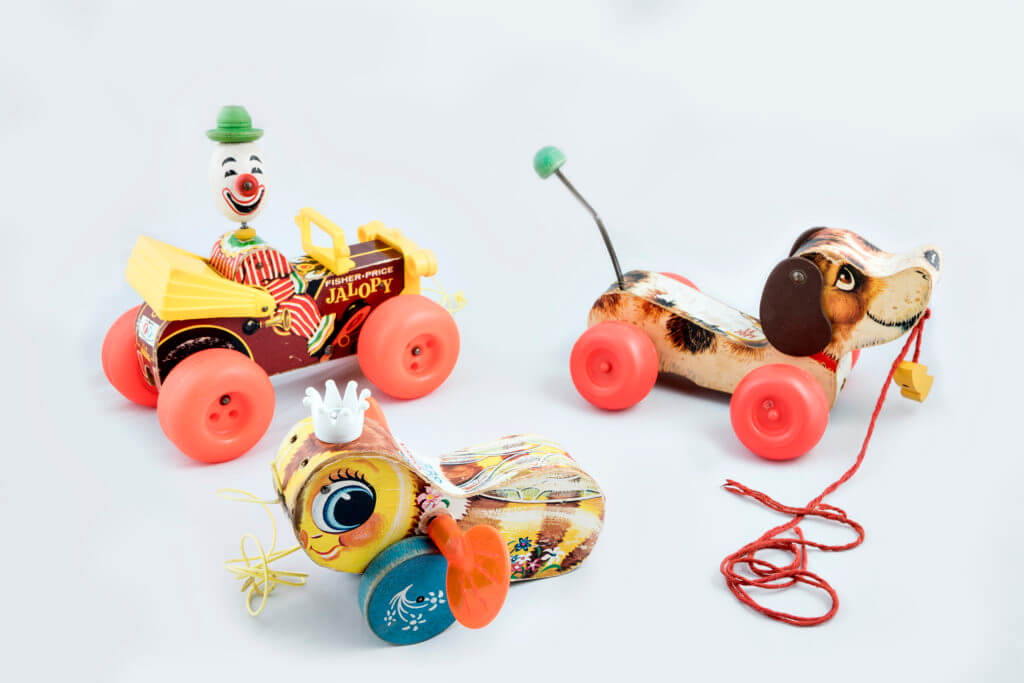
These toys were manufactured in the Fisher-Price factory in Orangeville, Dufferin County, Ontario. Each toy has a label that reads “Orangeville, Ontario” on the bottom. They were then purchased by local families and loved for many years and many generations of Dufferin–born children!
Fisher-Price toy manufacturers opened their first Canadian manufacturing plant in Orangeville in 1964 in the factory at 81 John Street. The factory had previously been used by Monarch Master Manufacturing, which manufactured coin-operated laundry machines.
The Fisher-Price plant employed 90 workers, most of whom were women who lived locally. It was at this time that working women across North America were demanding on-par wages with their male counterparts. In 1968, the Fisher-Price Orangeville employees went on strike in response to unfair wages.
Fisher-Price responded with the following statement in the Orangeville Banner: “Under the proposal to the union, all female employees will recieve at least $1.86 per hour, within eighteen months. (In some cases this represents a more than .65 cents per hour increase). This offer is the maximum we can afford at this time and continue to manufacture in Canada. This represents an annual payroll of well over 1/2 million dollars that is, for the most part, being spent in Orangeville and district. Fisher-Price is not anti-union. The above wage proposal is only part of the substantial offer which has been made in good faith and rejected by Union. It is up to the employees of the Orangeville plant whether we reopen for manufacture.”
An agreement could not be reached and the plant closed in August 1968 after an 18 week strike by employees. The company then packed up the machinery and left Orangeville.
History of Fisher-Price:
Founded in 1930 by Herman Fisher, Irving Price and Helen Schelle, the name Fisher-Price was established by combining two of the three founders’ names. The company sold their first toy, Mr. Doodle, in 1931. They were best known for their Little People toys. Mr. Price retired in 1969 and that year Fisher-Price was acquired by The Quaker Oats Company.
THE EDUCATION COLLECTION
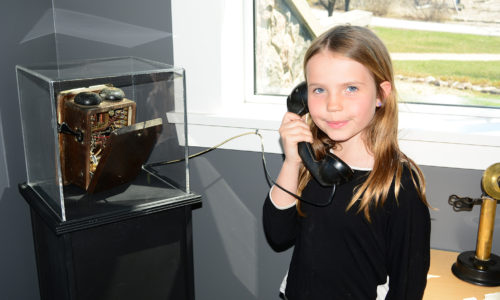
The Education Collection is a mixture of artifacts and archival documents used to support teaching and learning in exhibitions and during museum programs. Unlike the other collections, the education collection is hands-on. While we still handle these objects with great care, the public is able to get up-close and personal with this collection.
What We Have
The education collection has a variety of objects including, but not limited to:
- Reference books
- Photographs and postcards
- Textiles, including hats and military uniforms and insignia
- Housewares and cookware
- Historic tools
How to View
Pieces from the education collection are often utilized in our exhibit interactives, and are not otherwise displayed except when in use during programs. For questions about the Education Collection, please email Education.
FEATURED EDUCATION ARTIFACT
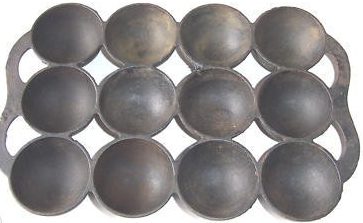
Just imagine…The smell of smoke and soot linger in the air. Wood is piled up by the door, chopped and ready for the fire box of the cooking stove. A large mixing bowl sits on the table, with ingredients splayed about. Mother’s apron is dusty with flour, and there is even a little in her hair. What delicious treat is being made today?
This artifact is part of the MoD’s education collection. It is often used as part of a hands-on activity in which students are encouraged to use thinking and inquiry skills to describe, question and evaluate the purpose, significance and story behind artifacts.
A gem is a muffin-like cake. Gems were a popular tea-time treat in the 19th and early 20th Centuries. They were usually made from graham flour, cornmeal, or oatmeal. The flour of choice was mixed with a few other simple ingredients such as water and salt, but recipes evolved to include milk/buttermilk, eggs, baking powder, and baking soda to help leaven the cakes. Occasionally fruit, brown sugar, molasses or maple syrup were added to the batter for sweetness.
Gems are traditionally baked in a heavy cast iron pan with rounded compartments. The key to baking them is to place the batter in a hot, well greased pan. Each section would be filled half way, and the batter would rise to fill the pan.
Gem pans came in a myriad of designs. Some manufacturers produced over a dozen variations. Nathaniel Waterman of Boston, Massachusetts is credited with having patented what is considered the quintessential gem pan design in 1859, which he referred to as an “egg pan”. His design featured cut-outs between each individual cup to allow for even circulation of heat around the cups. This would help ensure an evenly cooked gem.
Gem Recipe from the 19th C.
- 1 Cup milk
- 1 Tablespoon molasses
- 1 teaspoon salt
- 1 teaspoon baking soda
- Graham Flour to make a stiff dough.
Instructions:
Place spoonfuls into hot, greased pan and bake in hot oven until done (approx. 25 minutes).
